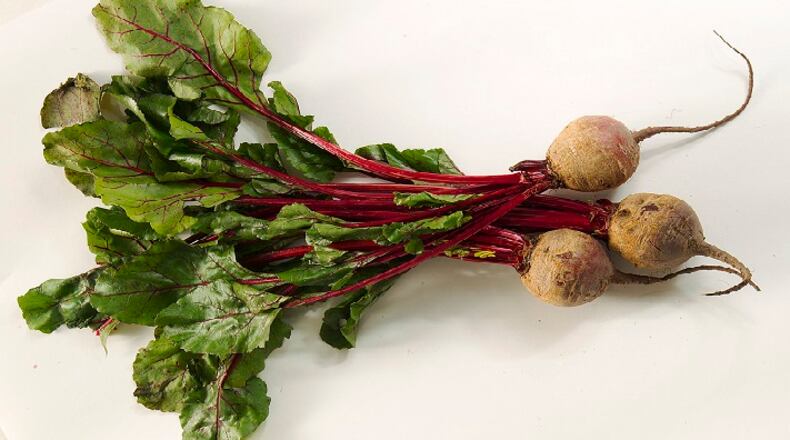Almost on a daily basis, I get asked about whether beet juice can help lower blood pressure. Here's some background and the bottom line.
People have been eating beetroot since the Middle Ages, according to Environment Nutrition newsletter. In modern times, it's the liquid version that has become popular. Beetroots are known as the red beet, table beet or garden beet, however they differ from the sugar beet, which is rarely eaten whole. Beetroots' unique benefits are mainly due to an abundance of dietary nitrate; when converted to nitric oxide in the body, it helps relax blood vessels, increase blood flow and promote oxygen uptake by muscle. Beetroots also contain betalains (which give beets their distinctive red color), flavonoids and phenolic compounds, which act as anti-inflammatory and antioxidant agents. Several studies show regular intake of beetroot juice lowers blood pressure in both normal and hypertensive adults.
In a small 2015 study, 14 healthy males drank a shot of beetroot juice for 15 days. Researchers measured blood pressure, oxygen uptake and cardiac output during rest and intense exercise and compared it to those who drank a placebo. Those taking beetroot juice had lower blood pressure and more dilated blood vessels and were able to work longer. However, other research has shown no effect on performance at all. Scientists think age, diet, physiology, training status, type of exercise as well as dose and duration of dose may all play a role in beetroot juice efficacy.
Studies on how beetroot juice affects people with heart disease and the elderly are more promising. One study found a daily dose of beetroot juice (about 2.5 ounces) significantly improved endurance and blood pressure in elderly patients with heart failure. Older adults consuming beetroot juice prior to moderate exercise were also found to have "younger" brains than those who did not drink any beetroot juice, according to Environmental Nutrition.
There is also question as to how much beetroot juice is needed, and the best time to consume it. Consumption in studies ranged from 2-3 ounces to as much as 2 cups daily, and the best time to consume it seems to be 1 1/2 hours before physical activity. But does it work if you don't exercise? More studies are needed.
The bottom line? It's not just the juice that may be helpful -- adding more beets as a vegetable can also help. But don't give up your blood pressure medicine for a couple of ounces of beetroot juice. It's always healthy to add more fruits and vegetables to your diet. But no one food can do miracles. It takes moderation, variety and balance for a healthy diet.
Q and A
Q: We're often told food sources of calcium are best, but calcium-fortified foods are often included in this advice. How are calcium-fortified foods any better than calcium supplements?
A: Food fortification is a long-standing and safe approach to boost intake of selected nutrients (for example, milk is fortified with vitamin D). For vegans and individuals who do not tolerate or care for dairy foods, which are the main sources of dietary calcium in the U.S., it can be challenging to meet the calcium requirement each day. The availability of healthful calcium-fortified foods, such as soymilk, tofu, whole-grain cereal and juice (in moderation) can be useful to these individuals. Including such foods is far better than having a calcium-deficient diet. Calcium is better absorbed and utilized if consumed in smaller amounts spread out during the day. Calcium-fortified foods typically contain smaller amounts of calcium than dedicated supplements. And, although people tend to focus on calcium and vitamin D for bone health, many other nutrients, such as potassium, magnesium, zinc, vitamin C and vitamin K, also are important for bones. These nutrients are best obtained as part of a healthful dietary pattern, which can include calcium-fortified foods. --Tufts University Health & Nutrition Letter.
RECIPE
With summer drawing to a close and the school bus heading your way, it's time to think about dinnertime routines. Cooking Light's "Fresh Food Fast" with 5 ingredient, 15 minute recipes, can be a lifesaver for those busy activity nights. Here's a recipe for Horseradish-Garlic Flank Steak, which gives grilled flank steak a tangy kick of spiciness. Serve with a salad and fresh fruit.
Horseradish-Garlic Flank Steak
2 tablespoons prepared horseradish
1 tablespoon olive oil
1/2 teaspoon salt
4 garlic cloves, minced
1 (1-pound) flank steak, trimmed
Cooking spray
Preheat grill to medium-high heat. Combine first 4 ingredients in a bowl, stirring with a whisk. Spread mixture onto both sides of steak. Place steak on grill rack coated with cooking spray. Grill 4 to 5 minutes on each side or until desired doneness. Remove from grill; let stand 5 minutes. Cut steak diagonally across grain into thin slices. Yield: 4 servings (serving size: 3 ounces).
Per serving: 198 calories, 24.7 g protein, 1.8 g carbohydrate, 9.6 g fat, 37 mg cholesterol, .3 g fiber, 377 mg sodium.
About the Author
The Latest
Featured


